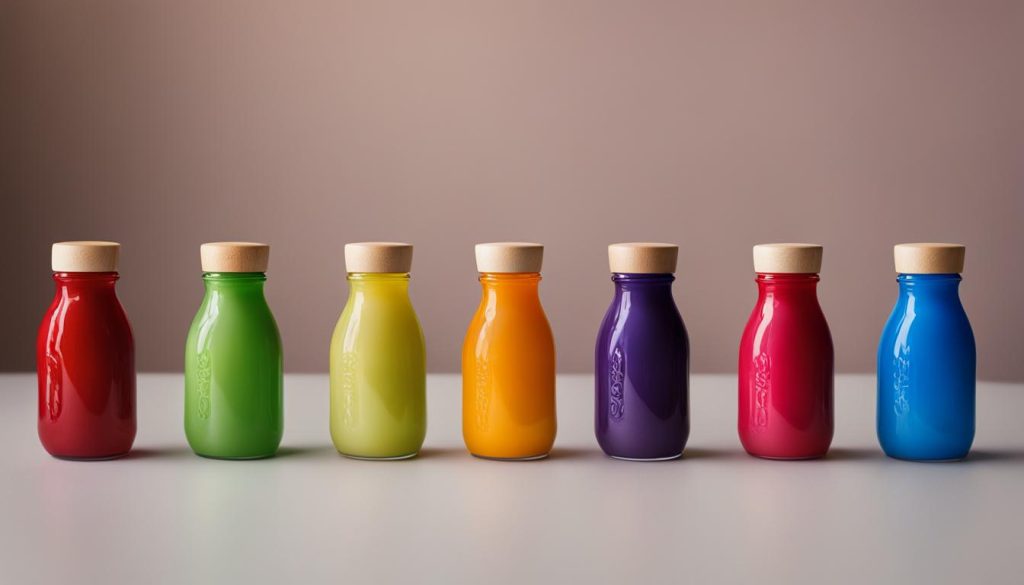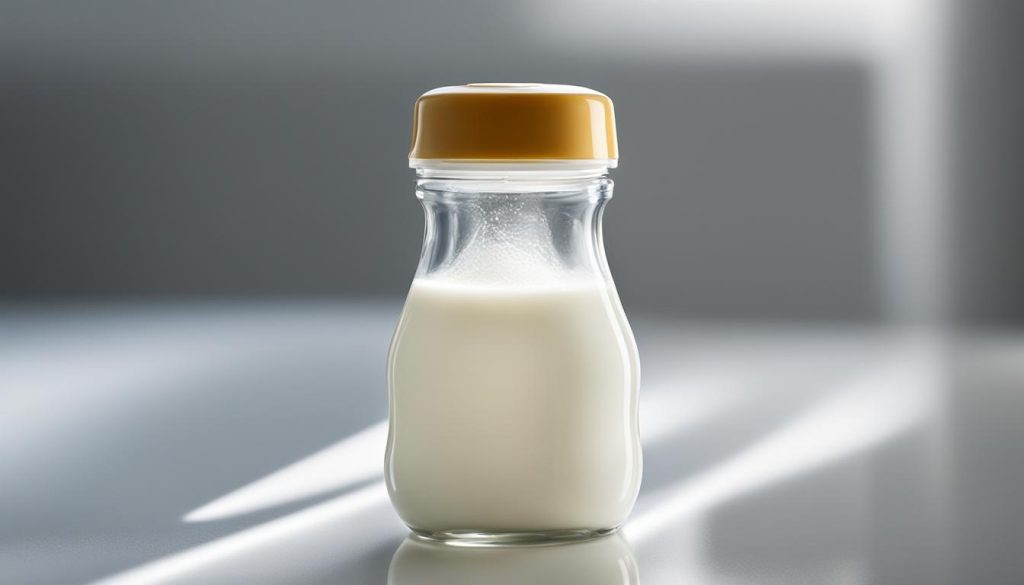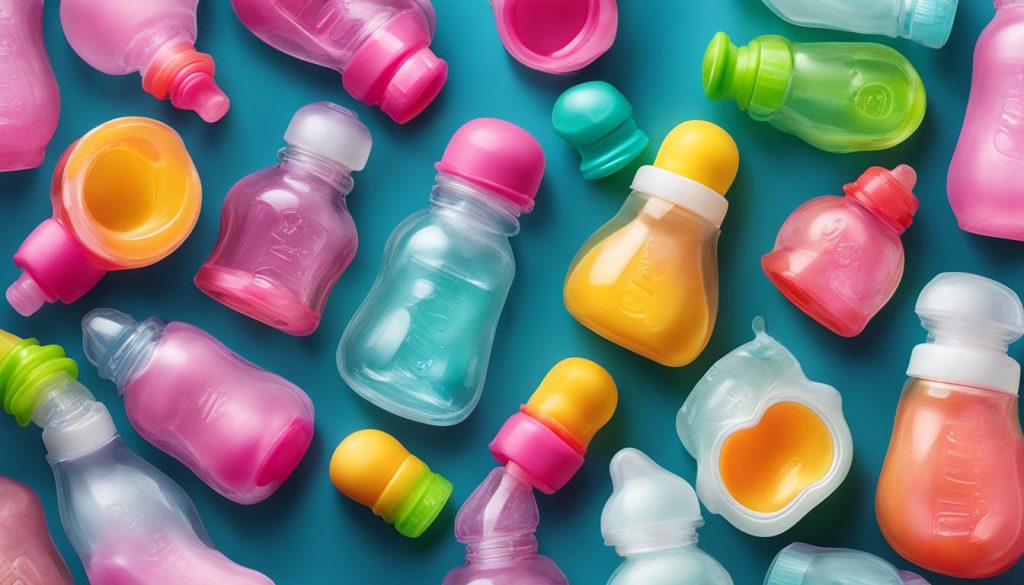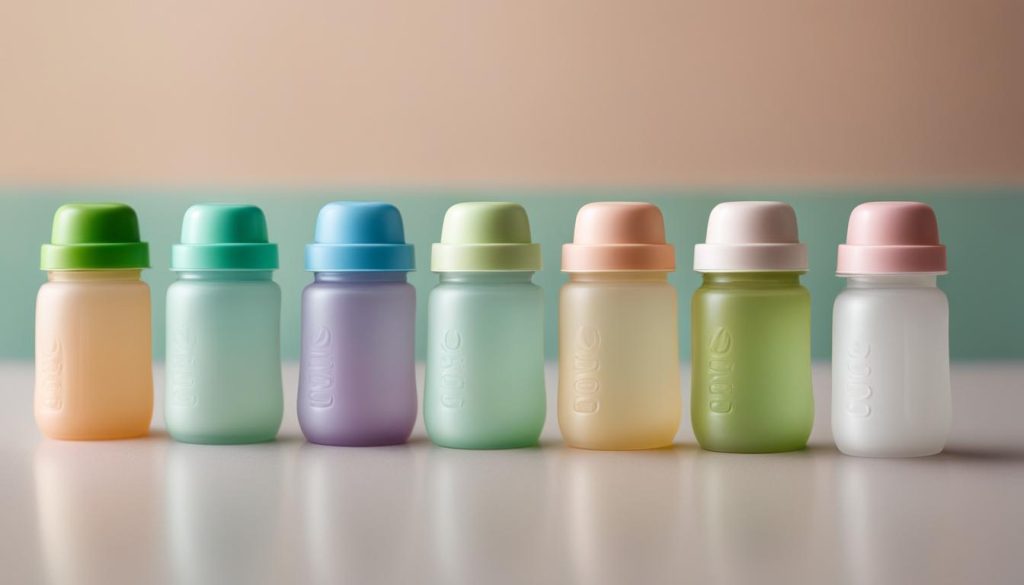Welcome to my article on the best slow flow bottles for newborns. If you’re a new parent, you know how important it is to choose the right bottle for your little one. Slow flow bottles are designed to mimic the natural breastfeeding experience and provide several benefits for newborns.
Slow flow bottles help newborns control the amount of milk they drink, preventing overfeeding and promoting healthy eating habits. They also reduce the risk of nipple confusion, a common issue when transitioning between breastfeeding and bottle feeding.
But with so many options available, how do you know which slow flow bottle is best for your baby? In this article, I’ll guide you through the top-rated slow flow bottles on the market, highlighting their high-quality features and benefits. From nipple type to design and cost, I’ll cover all the essential factors to consider when making your selection.
So, let’s dive in and discover the best slow flow bottles that will provide your newborn with a comfortable and enjoyable feeding experience.
Why Should You Use Slow-Flow Bottles
Slow-flow bottles are essential for newborns as they allow for better control over their milk intake. Newborns have small tummies and can only handle small amounts of milk at a time. Using slow-flow bottles ensures that their feeding is paced appropriately, preventing overfeeding and discomfort. This controlled flow mimics the natural breastfeeding experience, reducing the risk of nipple confusion when transitioning between bottle and breast.
Another benefit of using slow-flow bottles is the reduction of gas and spit-up. By slowing down the feeding process, babies are less likely to swallow air, which can lead to gas and colic. The slower flow also allows them to digest their food more effectively, minimizing regurgitation and spit-up.
Moreover, slow-flow bottles extend feeding time, which can be beneficial for both babies and parents. By encouraging a slower pace, babies have more time to realize when they are full, preventing overfeeding. Additionally, a longer feeding time gives parents a chance to bond with their little ones and enjoy the feeding experience.
The Benefits of Slow-Flow Bottles at a Glance:
- Control milk intake to prevent overfeeding
- Reduce the risk of nipple confusion
- Minimize gas and spit-up
- Extend feeding time for a more enjoyable experience
Using slow-flow bottles ensures a smooth and comfortable feeding experience for newborns, allowing them to control their milk intake, reducing gas and spit-up, and promoting bonding between babies and parents.
Now that we understand the benefits of slow-flow bottles, let’s explore how to choose the right one for your little one in the next section.
How to Choose a Slow-Flow Bottle
When it comes to selecting a slow-flow bottle for your newborn, there are a few key factors to consider. One of the first things to think about is the type of nipple. Latex nipples are softer and mimic the feel of a real breast, while silicone nipples are firmer and tend to last longer. You should choose the nipple material that best suits your baby’s preference and needs.
The design of the bottle is also an important consideration. Wide-base bottles are easier to hold and provide stability during feeding sessions. On the other hand, narrow-base bottles are more convenient for traveling and fitting into smaller diaper bags. Think about how you plan to use the bottle and choose a design that aligns with your lifestyle.
Cost is always a factor when making a purchase. The good news is that there are affordable slow-flow bottle options available that work just as well as more expensive bottles. It’s important to note that a higher price tag doesn’t always equate to better quality or performance. Take the time to compare prices and read reviews to find the best slow-flow bottle within your budget.
| Nipple Type | Design | Cost |
|---|---|---|
| Latex or Silicone | Wide-base or Narrow-base | Affordable options available |
By considering the nipple type, design, and cost, you can make an informed decision when choosing a slow-flow bottle for your little one. Remember, every baby is different, so it may take some trial and error to find the bottle that works best for your child’s feeding needs.
Expert Recommendations for Slow-Flow Bottles
When it comes to choosing the best slow flow bottles for newborns, experts have weighed in on their top recommendations. These bottles are known for their high quality, innovative designs, and effectiveness in mimicking the breastfeeding experience. Here are some of the expert-recommended slow flow bottles that can help make feeding time a breeze:
“The Nanobébé Flexy Silicone Baby Bottles are a fantastic choice for newborns. With their unique squishy feel and wide base for stability, these bottles offer a comfortable and secure grip for both babies and parents. Plus, the silicone material is easy to clean and sterilize.” – Dr. Jennifer Carter, Pediatrician
The Boon NURSH Silicone Bottles stand out for their innovative design. These bottles feature reusable silicone pouches inside, which help reduce air ingestion and minimize gas and colic. The pouches are easy to clean and sterilize, making them a convenient choice for busy parents.
- Nanobébé Flexy Silicone Baby Bottles
- Boon NURSH Silicone Bottles
- Tommee Tippee Closer to Nature Baby Bottle
- POTATO Newborn Baby Bottles
- Dr. Brown’s Anti-Colic Options+ Narrow Baby Bottles
- Comotomo Baby Bottles
The Tommee Tippee Closer to Nature Baby Bottle is highly recommended for its breast-like nipple, which allows for a more natural latch and feeding experience. These bottles are also designed to reduce colic and discomfort, making them a popular choice among parents.
For parents looking for the smallest capacity bottles available, the POTATO Newborn Baby Bottles are an excellent option. These bottles are specifically designed for newborns and hold just the right amount of milk for each feeding.
Lastly, the Dr. Brown’s Anti-Colic Options+ Narrow Baby Bottles are known for their internal venting system, which helps reduce colic, gas, and spit-up. These bottles are highly recommended for infants who struggle with feeding issues.
Expert recommendations for slow-flow bottles:
| Brand | Key Features |
|---|---|
| Nanobébé Flexy Silicone Baby Bottles | Squishy feel, wide base for stability |
| Boon NURSH Silicone Bottles | Reusable silicone pouches, reduce air ingestion |
| Tommee Tippee Closer to Nature Baby Bottle | Breast-like nipple, reduces colic |
| POTATO Newborn Baby Bottles | Smallest capacity, ideal for newborns |
| Dr. Brown’s Anti-Colic Options+ Narrow Baby Bottles | Internal venting system, reduces colic and gas |
| Comotomo Baby Bottles | Soft, squishy feel |
Tips for Using Slow-Flow Bottles
When it comes to using slow-flow bottles for newborns, proper sterilization and maintenance are crucial for their health and well-being. Here are some tips to ensure safe and effective use:
1. Sterilization:
Before using a slow-flow bottle, it’s important to sterilize it to eliminate any harmful bacteria. You have several options for sterilization:
- Boiling Water: Place the bottle and its parts in a pot of boiling water for at least five minutes. Make sure all the components are fully submerged.
- Sterilizer: Use a microwave or electric steam sterilizer, following the manufacturer’s instructions. This method is quick, easy, and efficient.
- Dishwasher: If your bottle is dishwasher-safe, you can clean and sterilize it by placing it on the top rack of your dishwasher.
Regardless of the method you choose, be sure to let the bottles air dry or use a clean towel to dry them thoroughly
2. Regular Cleaning:
In addition to sterilization, regular cleaning is necessary to maintain the hygiene of your slow-flow bottles. After each use, disassemble the bottle and clean all the parts with warm, soapy water. Use a bottle brush to reach all the nooks and crannies, especially the nipple. Rinse the bottle and its parts thoroughly to remove any soap residue. Allow them to air dry or use a clean towel to dry them before use.
3. Check for Wear and Damage:
Inspect your slow-flow bottles regularly for any signs of wear or damage. Check the nipples for cracks or tears, as these can affect the flow and integrity of the bottles. If you notice any issues, replace the bottle or nipple immediately to ensure your baby’s safety.
4. Follow Manufacturer’s Instructions:
It’s important to read and follow the manufacturer’s instructions for proper use and care of your slow-flow bottles. Each brand may have specific guidelines for sterilization, cleaning, and maintenance. Adhering to these instructions will help ensure the longevity and effectiveness of your bottles.
By following these tips for using slow-flow bottles, you can provide your newborn with a safe and hygienic feeding experience. Remember to properly sterilize your bottles, clean them regularly, check for wear and damage, and follow the manufacturer’s instructions. Your baby’s health and well-being are worth the extra effort!
Conclusion
After considering the various factors involved in choosing a slow-flow bottle for your newborn, it is clear that these bottles play a crucial role in enhancing their feeding experience. Slow flow bottles allow for better control of milk intake and help prevent nipple confusion, reducing the chances of your little one having difficulty transitioning between bottle and breastfeeding.
Besides promoting feeding control, slow-flow bottles are also effective in minimizing gas and spit-up, as they encourage babies to drink at a gentler pace. Additionally, the extended feeding time provided by these bottles can offer a much-needed break for parents.
When searching for the perfect slow-flow bottle, take into consideration the nipple type, design, and cost. The market offers a variety of options, but according to experts, the Nanobébé Flexy Silicone Baby Bottles, Boon NURSH Silicone Bottles, Tommee Tippee Closer to Nature Baby Bottle, POTATO Newborn Baby Bottles, Dr. Brown’s Anti-Colic Options+ Narrow Baby Bottles, and Comotomo Baby Bottles are among the best choices for newborns.
Remember to keep your slow-flow bottles properly sterilized and maintained for both safety and effectiveness. By following these guidelines, you can ensure a positive feeding experience for your precious baby.
FAQ
What are slow-flow bottles?
Slow-flow bottles are designed to control the amount of milk newborns drink and mimic the breastfeeding experience.
How do slow-flow bottles help newborns?
Slow-flow bottles prevent nipple confusion, reduce gas and spit-up, and extend feeding time for newborns.
How should I choose a slow-flow bottle?
When choosing a slow-flow bottle, consider the nipple type, design, and cost.
What are some recommended slow-flow bottles for newborns?
Experts recommend the Nanobébé Flexy Silicone Baby Bottles, Boon NURSH Silicone Bottles, Tommee Tippee Closer to Nature Baby Bottle, POTATO Newborn Baby Bottles, Dr. Brown’s Anti-Colic Options+ Narrow Baby Bottles, and Comotomo Baby Bottles.
How should I use slow-flow bottles?
Properly sterilize the bottles before each use, regularly clean them, and follow the manufacturer’s instructions for safe and effective use.




